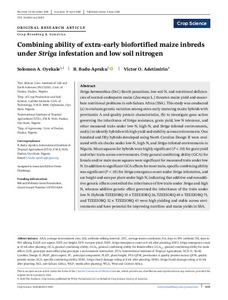| dc.contributor.author | Oyekale, S.A. |
| dc.contributor.author | Badu‐Apraku, B. |
| dc.contributor.author | Adetimirin, V.O. |
| dc.date.accessioned | 2022-08-10T09:39:45Z |
| dc.date.available | 2022-08-10T09:39:45Z |
| dc.date.issued | 2020-07 |
| dc.identifier.citation | Oyekale, S.A., Badu‐Apraku, B. & Adetimirin, V.O. (2020). Combining ability of extra‐early biofortified maize inbreds under Striga infestation and low soil nitrogen. Crop Science, 60(4), 1925-1945. |
| dc.identifier.issn | 0011-183X |
| dc.identifier.uri | https://hdl.handle.net/20.500.12478/7626 |
| dc.description.abstract | Striga hermonthica (Del.) Benth parasitism, low soil N, and nutritional deficiencies of normal‐endosperm maize (Zea mays L.) threaten maize yield and exacerbate nutritional problems in sub‐Sahara Africa (SSA). This study was conducted (a) to evaluate genetic variation among extra‐early maturing maize hybrids with provitamin A and quality protein characteristics, (b) to investigate gene action governing the inheritance of Striga resistance, grain yield, low N tolerance, and other measured traits under low‐N, high‐N, and Striga‐infested environments, and (c) to identify hybrids with high yield and stability across environments. One hundred and fifty hybrids developed using North Carolina Design II were evaluated with six checks under low‐N, high‐N, and Striga‐infested environments in Nigeria. Mean squares for hybrids were highly significant (P < .01) for grain yield and other traits across environments. Only general combining ability (GCA) for female and/or male mean squares were significant for measured traits under low N. In addition to significant GCA effects for most traits, specific combining ability was significant (P < .05) for Striga emergence count under Striga infestation, and ear height and ears per plant under high N, indicating that additive and nonadditive genetic effects controlled the inheritance of few traits under Striga and high N, whereas additive genetic effect governed the inheritance of the traits under low N. Hybrids TZEEIORQ 55 × TZEEIORQ 26, TZEEIORQ 49 × TZEEIORQ 75, and TZEEIORQ 52 × TZEEIORQ 43 were high yielding and stable across environments and have potential for improving nutrition and maize yields in SSA. |
| dc.description.sponsorship | Bill & Melinda Gates Foundation |
| dc.format.extent | 1925-1945 |
| dc.language.iso | en |
| dc.subject | Maize |
| dc.subject | Malnutrition |
| dc.subject | Provitamins |
| dc.subject | Striga Hermonthica |
| dc.subject | Nigeria |
| dc.title | Combining ability of extra‐early biofortified maize inbreds under Striga infestation and low soil nitrogen |
| dc.type | Journal Article |
| cg.contributor.crp | Maize |
| cg.contributor.affiliation | University of Ibadan |
| cg.contributor.affiliation | Ladoke Akintola University of Technology |
| cg.contributor.affiliation | International Institute of Tropical Agriculture |
| cg.coverage.region | Africa |
| cg.coverage.region | West Africa |
| cg.coverage.country | Nigeria |
| cg.coverage.hub | Headquarters and Western Africa Hub |
| cg.researchtheme | Biotech and Plant Breeding |
| cg.identifier.bibtexciteid | OYEKALE:2020 |
| cg.isijournal | ISI Journal |
| cg.authorship.types | CGIAR and developing country institute |
| cg.iitasubject | Food Security |
| cg.iitasubject | Maize |
| cg.iitasubject | Nutrition |
| cg.iitasubject | Plant Breeding |
| cg.iitasubject | Plant Production |
| cg.journal | Crop Science |
| cg.notes | Published online: 06 May 2020 |
| cg.accessibilitystatus | Open Access |
| cg.reviewstatus | Peer Review |
| cg.usagerightslicense | Creative Commons Attribution 4.0 (CC BY 0.0) |
| cg.targetaudience | Scientists |
| cg.identifier.doi | https://dx.doi.org/10.1002/csc2.20195 |
| cg.iitaauthor.identifier | BAFFOUR BADU-APRAKU: 0000-0003-0113-5487 |
| cg.futureupdate.required | No |
| cg.identifier.issue | 4 |
| cg.identifier.volume | 60 |

